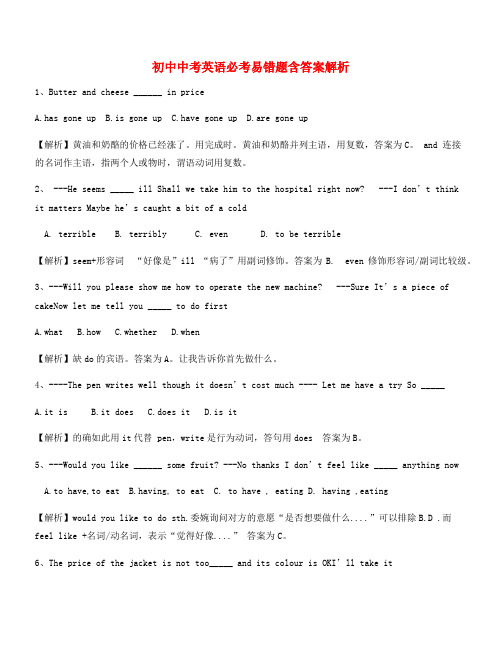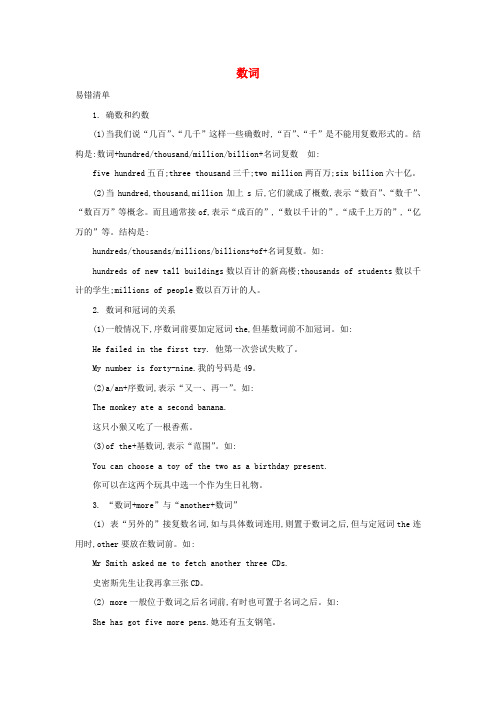中考英语常考易错点专题讲练完成句子和句子翻译含复习资料解析
(完整版)2019-2020年中考英语常考易错点专题二十二完成句子和句子翻译.docx

2019-2020 年中考英语常考易错点专题二十二完成句子和句子翻译知清1. It's+ adj .+for sb.+to do sth.某人来做某事怎么 , 如 :It is dangerous for children to play in the street.孩子在街上玩是很危的。
2. It's time for sth.是干某事的了 ;It's time(for sb.)to do sth.干某事了。
如 :①It's time for the meeting.开会了。
②It's time for us to go to school.我上学了。
3. It takes sb. some time to do sth.干某事花某人一些。
sb. spend some time/money on sth./(in)doing sth.某人花 ( 金 ) 在某事上 /花 ( 金 ) 干某事。
sth. cost sb. some money某事花某人一些pay some money for sth.某事 ( 物 ) 付 , 如 :①It took me two hours to write the letter.写封信花了我两小的。
②He spends half an hour(in)reading English every morning.他每天早上花半小英。
③He spends one hour on the housework every day.他每天花一小做家。
④The bike cost me 500.自行花了我500元。
yuan⑤I spent 500yuan on the bike.我自行花了500 元。
⑥I paid 500yuan for the bike.我花了 500 元自行。
重要提示 :cost主一般物;spend, pay主一般人。
中考英语易错题专项训练精选(含答案及解析)

初中中考英语必考易错题含答案解析1、Butter and cheese ______ in priceA.has gone upB.is gone upC.have gone upD.are gone up【解析】黄油和奶酪的价格已经涨了。
用完成时。
黄油和奶酪并列主语,用复数,答案为C。
and 连接的名词作主语,指两个人或物时,谓语动词用复数。
2、 ---He seems _____ ill Shall we take him to the hospital right now? ---I don’t thinkit matters Maybe he’s caught a bit of a coldA. terribleB. terriblyC. evenD. to be terrible【解析】seem+形容词“好像是”ill “病了”用副词修饰。
答案为B. even修饰形容词/副词比较级。
3、---Will you please show me how to operate the new machine? ---Sure It’s a piece of cakeNow let me tell you _____ to do firstA.whatB.howC.whetherD.when【解析】缺do的宾语。
答案为A。
让我告诉你首先做什么。
4、----The pen writes well though it doesn’t cost mu ch ---- Let me have a try So _____A.it isB.it doesC.does itD.is it【解析】的确如此用it代替 pen,write是行为动词,答句用does 答案为B。
5、---Would you like ______ some fruit? ---No thanks I don’t feel like _____ anything nowA.to have,to eatB.having, to eatC. to have , eatingD. having ,eating【解析】would you like to do sth.委婉询问对方的意愿“是否想要做什么....”可以排除B.D .而feel like +名词/动名词,表示“觉得好像....” 答案为C。
中考英语查补易混易错短文填空解析版

149.句意:它听起来如此悲伤,以致于当我听的时候几乎哭了。根据“It sounded so sad that I almost cried along with it…I listened.”可知,此处表示“当听的时候”,用备选词as引导时间状语从句,故填as。
150.句意:后来我知道这首歌是由民间音乐家阿炳写的。根据“Later I got to know the music was…by a folk musician Abing.”和常识可知,《二泉映月》是阿炳写的,选择write,用于“was done”结构中表示被动,故填written。
易错点03:词汇量不够,写错单词。要判断所填词应采用的正确词形。若为名词,应注意其单复数、可数还是不可数及其所有格形式;若为动词,应注意人称、数、时态、语态及非谓语动词形式;若为修饰语,应注意修饰名词或代词时用形容词,而修饰动词、形容词、副词或全句时要用副词;若为代词,注意代词的各种形式;若为形容词、副词,应注意比较等级变化;若为数词,要注意基数词与序数词的正确选择。
On Thursday Planting Days, the FUF plants “replacement (替换) trees”. As their name suggests, these trees replace trees142. Planting Leaders are very experienced volunteers. They are able to help other volunteers at planting events. Planting Leaders usually wear a special FUF T-shirt. Some new volunteers know little about “replacement trees”. They can easily find Planting Leaders and143.
中考英语常考易错点专题讲练:简单句(含答案解析)

简单句易错清单一、陈述句的否定结构1. 含有have的否定句(1) have当“拥有,所有”讲时,其否定形式有两种。
如:I have an e-dictionary. 我有一个电子词典。
可改为:I don't have an e-dictionary. (√)I have not an e-dictionary. (√)(2) have作“吃、喝、玩、度过”讲时,其否定形式借助于助动词do。
如:I had milk for breakfast this morning. (变否定句) →I didn't have milk for breakfast this morning.(3) have为助动词时,其否定形式为haven't。
如:I have visited Diaoyu Island. (变否定句) →I haven't visited Diaoyu Island.2. 注意以下几种情况:(1)含有all, both, each, every, both...and...等的肯定句加not变为否定句后,只表示部分否定;若表示全部否定,则需分别用no, no one, nobody, none, neither, neither...nor...等词替换上述词。
如:Both Mary and Joan are students→Neither Mary nor Joan is a student.(2)含有already (已经),too (也)的肯定句加not变为否定句时,要分别把already和too改为yet和either。
如:He has already seen the movie. (变为否定句) →He hasn't seen the movie yet.I want to go for a picnic, too. (变否定句) →I don't want to go for a picnic,either.(3)含有almost, many, much, often等词的肯定句可直接用never (hardly),few, little, seldom变为否定句,而不用加not。
中考英语常考易错点专题讲练:名词(含答案解析)

名词易错清单1. information,message,news(1) information作“信息”解,通常指在阅读、观察、谈话或书信往来中特别关注的消息、情报、资料等。
它侧重内容,是不可数名词。
如:They must find out some information about planes to Kunming as quickly as possible.他们必须尽快查到有关飞往昆明班机的信息。
(2)news作“新闻”解,一般指通过广播、电视、报纸等新闻媒体向大众发布的社会各方面的最新消息,它侧重一个“新”字,是不可数名词。
如:There's a piece of interesting news in today's newspaper. 在今天的报纸上有一条有趣的消息。
No news is good news.没消息就是好消息。
(3)message作“音信”解,一般指口头传递的或书写的“消息”,是可数名词。
如:She often sends messages to me with her mobile phone.她经常给我发手机短信。
2. noise,voice,sound(1) sound “声音”,为最常用词,指可以听到的任何声音,强的,弱的,令人愉快的或不愉快的,有意义的或无意义的。
如:I was reading last night,when suddenly I heard a sound in the next room.昨晚我正看书时,突然听到隔壁房间有声音。
(2) noise 常指太响或人们不愿听到的声音,“嘈杂声、喧闹声”。
如:The boys made too much noise.孩子们太吵闹了。
(3) voice 指“说话声”“唱歌声”“嗓音”如:That sounds like Mary's voice. 那声音听起来好像玛丽的声音。
中考英语常考易错点专题讲练:数词(含答案解析)

数词易错清单1. 确数和约数(1)当我们说“几百”、“几千”这样一些确数时,“百”、“千”是不能用复数形式的。
结构是:数词+hundred/thousand/million/billion+名词复数如:five hundred五百;three thousand三千;two million两百万;six billion六十亿。
(2)当hundred,thousand,million加上s后,它们就成了概数,表示“数百”、“数千”、“数百万”等概念。
而且通常接of,表示“成百的”,“数以千计的”,“成千上万的”,“亿万的”等。
结构是:hundreds/thousands/millions/billions+of+名词复数。
如:hundreds of new tall buildings数以百计的新高楼;thousands of students数以千计的学生;millions of people数以百万计的人。
2. 数词和冠词的关系(1)一般情况下,序数词前要加定冠词the,但基数词前不加冠词。
如:He failed in the first try. 他第一次尝试失败了。
My number is forty-nine.我的号码是49。
(2)a/an+序数词,表示“又一、再一”。
如:The monkey ate a second banana.这只小猴又吃了一根香蕉。
(3)of the+基数词,表示“范围”。
如:You can choose a toy of the two as a birthday present.你可以在这两个玩具中选一个作为生日礼物。
3. “数词+more”与“another+数词”(1) 表“另外的”接复数名词,如与具体数词连用,则置于数词之后,但与定冠词the连用时,other要放在数词前。
如:Mr Smith asked me to fetch another three CDs.史密斯先生让我再拿三张CD。
中考英语易错题重点习题大全含答案解析

初中中考英语必考易错题含答案解析1、 ---Here is a piece of paper for you! ---Oh, thanks It’s for me to write a long letter onA. big enoughB. enough largeC. small enoughD. enough small【解析】enough 足够的,修饰形容词时放在形容词后面。
根据题意,答案为A。
足够大才能写。
2、---Something is wrong with the car ---Don’t worryI’ll have it _______ soonA.fixedB.mending C .to repair D. to fix【解析】have 后面接过去分词作宾语补足语,过去分词所表示的动作由他人完成。
后面接不带to的不定式作宾补,表示让某人做某事接现在分词作宾补,表示让.......一直做某事答案为A。
3、I haven’t got a chair ______ Will you make room for me?A. to sitB. to sit inC. for sittingD. sitting on【解析】sit是不及物动词,AC可排除。
因为椅子有扶手,要用 sit in。
答案为B。
4、 ---You must what I have done for you before you leave ---Well, how much doesit_____? Is dollars enough?A. pay for, costB. pay, spendC. spend, pay forD. pay, cost【解析】为某事支付用pay for. 某事花费多少钱,用cost。
spend 一般由人作主语。
答案为A。
5、---Shall we leave for home now? ---No, I ______ here until Tom comes backA.won’t waitB.will leaveC.will waitD. won’t stay【解析】C为我将等,直到TOM回来。
中考英语专题讲练现在完成时(含解析)

现在完成时现在完成时知识精讲一、现在完成时表示过去发生的动作对现在造成的影响或结果或表示过去的动作或状态持续到现在。
二、句子结构主语+ has/have + done (过去分词)三、基本用法四、时间状语1. yet (常用于否定或疑问句中), already (常用于肯定句中)2. since+过去时间点/过去时的从句(译为:自从…以来)3. for+时间段4. just, so far, recently, never, ever, twice…5. in the past / last few days五、动词过去分词的规则变化六、动词过去分词的不规则变化:七、相关句式八、瞬间动词和延续性动词之间的转换:在完成时中,一个瞬间动词不能直接与表示一段时间的状语(for, since等)连用。
此时须将该瞬间动词改为延续性动词或状态动词:例:The film began five minutes ago.---The film has been on for five minutes.---It has been five minutes since the film began.用“be+形容词”代终止性动词1. “ be+married”代替marry2. “be+ill”代替fall (get) ill3. “be+dead”代替die4. “be+asleep”代替fall (get) asleep5. “be+awake”代替wake/wake up6. “be+gone”代替lose, die, sell, leave7. “be+open”代替open8. “be closed”代替close/shut用“be+副词”代终止性动词1. “be+on”代替start, begin2. “be+up”代替get up3. “be+back(to)”代替return to, come back to, go back to4. “be here (there)”代替come(arrive, reach, get) here或go (arrive, reach, get) there等等用“be+介词短语”代终止性动词1.”be in/at +地点”代替go to /come to2.”用be in the army”代替join the army3.”be in/at +地点”代替move to三点剖析一、考点:现在完成时的基本用法和时间状语;以及动词过去分词的变化规则。
- 1、下载文档前请自行甄别文档内容的完整性,平台不提供额外的编辑、内容补充、找答案等附加服务。
- 2、"仅部分预览"的文档,不可在线预览部分如存在完整性等问题,可反馈申请退款(可完整预览的文档不适用该条件!)。
- 3、如文档侵犯您的权益,请联系客服反馈,我们会尽快为您处理(人工客服工作时间:9:00-18:30)。
完成句子和句子翻译知识清单1. It's+adj.+for sb.+to do sth. 对某人来说做某事怎么样,如:It is dangerous for children to play in the street. 孩子们在街上玩是很危险的。
2. It's time for sth. 是干某事的时间了;It's time(for sb.)to do sth. 该干某事了。
如:①It's time for the meeting. 该开会了。
②It's time for us to go to school. 我们该上学了。
3. It takes sb. some time to do sth. 干某事花某人一些时间。
sb. spend some time/money on sth./(in)doing sth. 某人花时间(金钱)在某事上/花时间(金钱)干某事。
sth. cost sb. some money 某事花某人一些钱pay some money for sth. 为某事(物)付钱,如:①It took me two hours to write the letter. 写这封信花了我两小时的时间。
②He spends half an hour(in)reading English every morning. 他每天早上花半小时读英语。
③He spends one hour on the housework every day. 他每天花一小时做家务。
④The bike cost me 500 yuan. 这辆自行车花了我500元。
⑤I spent 500 yuan on the bike. 我买这辆自行车花了500元。
⑥I paid 500 yuan for the bike. 我花了500元买这辆自行车。
重要提示:cost主语一般为物;spend, pay主语一般为人。
例①中it 用作形式主语,动词不定式为真正主语。
4. too+形容词/副词+to do... 太……以致不能……如:①I was too excited to say a word.我激动得一个字也说不出来。
②Tom is too short to reach the apple.Tom太矮了,拿不到那个苹果。
重要提示:这是一个否定句型,不能在不定式前加 not,可以用so... that... 结构改写。
例句①可以改写成:I was so excited that I couldn’t say a word.5. so that... 以便/以致……如:①They studied hard so that they could pass the exam. 为了能通过考试,他们学习很努力。
②They started early so that they caught the early bus. 他们起得很早,结果赶上了早班车。
重要提示:在例句①中,是引导目的状语;在例句②中,是引导结果状语。
一般来讲,若从句中含有情态动词,则so that引导的为目的状语。
若无情态动词,则so that引导的为结果状语。
6. 祈使句+then/or/and+陈述句如:①Work hard,and/then/and then you will live a happy life. 努力工作,你就会过上幸福的生活。
②Hurry up,or we will be late for school. 快点,否则我们上学就迟到了。
注意:以上句型都可以用条件状语从句来改写。
例句②可以改写成:If we don't hurry up,we'll be late for school.7. Why not do...? 为什么不……?Let's do... 让我们做……吧。
Shall we do...?我们做……好吗?Would you like/to do...?你想要(做)……吗?Will you please do...?请你做……好吗?What(How)about doing...?做……怎么样?had better do/not do sth.最好做/不做某事。
如:①—Why not go and ask our teacher?——为什么不去问问老师?—Good idea! Let's go. ——好主意!走吧!②—Shall we go out for a walk? ——我们去散步怎么样?—No,Let's go to the zoo. ——不,我们去动物园吧。
③Will you please fetch some chalks for me? 请你给我拿些粉笔,好吗?④—What about singing an English song? ——唱首英文歌曲怎么样?—Wonderful! ——好极了!⑤You had better put on the coat when you go out. 你出去时最好把外套穿上。
8. I don't think his answer is right.我认为他的答案不对。
如:①I can't believe she is right. 我相信她是不对的。
②You don't think they will come tomorrow,do you? 你认为他们明天不会来,是吗?重要提醒:think,believe,suppose等接宾语从句,表示否定时否定主句。
变为反意疑问句时,若主语是第一人称,简短问句与宾语从句的主谓语保持一致,若主句主语是其他人称,与主句主谓语保持一致。
例句①变为反意疑问句应为:I can't believe she is right,is she?9. such+名词性词组+that...;so+形容词/副词+that... 如此……以致……如:①She is such a good teacher that we all love her. 她是一个好老师,我们都爱她。
②It was such a hot day that they didn't go out for a walk as usual. 这么热的天气,他们没有像往常一样去散步。
重要提醒:(1)“such+a(an)+形容词+名词+that...”,可以改写成“so+形容词+a(an)+名词+that...”,例句①可以改写成:She is so good a teacher that we all love her.(2)在“such+形容词+名词复数或不可数名词+that...”结构中,形容词如果是many/few 或much/little时,用so不用such,即:so+many/few+可数名词复数+that... ,so+much/little+不可数名词+that... 。
如:①There are so many people in the room that I can't get in.房间里人太多,我进不去。
②The man has so much money that he can buy a car.那人很有钱,他能买一辆小汽车。
10. there be...;either... or...;neither... nor...;not only... but also... 如:①There is a pen and two pencils in his pencil-box. 他的铅笔盒里有一支钢笔和两支铅笔。
②Not only you but also I want to go travelling.不但你,我也想去旅游。
③Either you or I am leaving for Shanghai.要么你去上海,要么我去上海。
④Neith er you nor he is right. 你和他都不对。
⑤Both Jack and Tim are English. Jack和Tim都是英国人。
重要提示:当这几个句型连接主语时,谓语动词的人称和数要遵循“就近原则”。
对比both... and... 来记忆,both... and... 连接主语时视为复数。
11. enough+名词+to do... 有足够的……做某事;形容词/副词+enough+to do... 足够……做某事。
如:①There is enough room to hold these people to have a meeting. 这儿有足够的地方容下这些人开会。
②The boy is strong enough to carry the heavy box. 这个男孩儿力气够大,能搬动这只箱子。
重要提示:enough作副词修饰形容词或副词时,放在所修饰词的后面,句子可以用so... that... 句型改写。
例句②可以改写为:The boy is so strong that he can carry the heavy box.12. enjoy doing sth. 喜欢(爱好)做某事;like to do/like doing sth. 喜欢做某事。
如:①Do you enjoy listening to music? 你喜欢听音乐吗?②I like to swim in the swimming pool. 我喜欢在游泳池中游泳。
(喜欢到某一具体的地方游泳)③I like swimming. 我喜欢游泳。
(只讲喜欢这项运动)提分策略纵观全国各地中考英语试题的句子翻译题,其考查的重点为:各类重要句型结构及搭配、重点词的用法及习惯表达、主要语法规则及其运用等,为了便于评分,大多题型用“翻译填空”即“完成句子”来考查学生“译”的能力,此种题型一般占试卷总分的百分之十左右。
解答这类试题,考生需要注意以下方面:1. 要明确命题意图,做到有的放矢。
一般说来,句子翻译都有个明显的考查意图,要么是考查某个词的用法或习惯表达,要么是考查某个句型的结构或搭配,或者是考查某条语法规则的具体运用,等等。
在做题时若能明确命题者的考查意图,那么便可加强做题的针对性,从而做到有的放矢。
2. 要注意英语的习惯表达以及英汉两种语言的不同之处。
由于历史、文化等方面的原因,英汉两种语言在用词选句等方面有许多不同之处,这一点考生一定要引起足够的重视,千万不要用汉语的习惯硬套英语句型。
比如:汉语中常说“希望/建议/同意/拒绝某人做某事”,但英语习惯上却不能 hope/suggest/agree/refuse sb. to do sth.;又比如:汉语中的“红茶”,按英语的习惯是说成 black tea,而不是对应地说成red tea。
